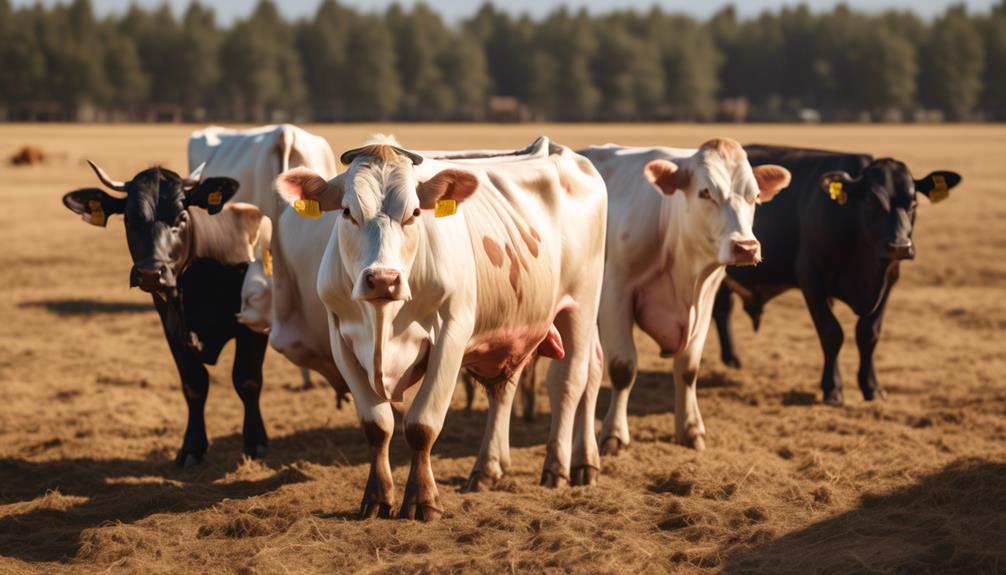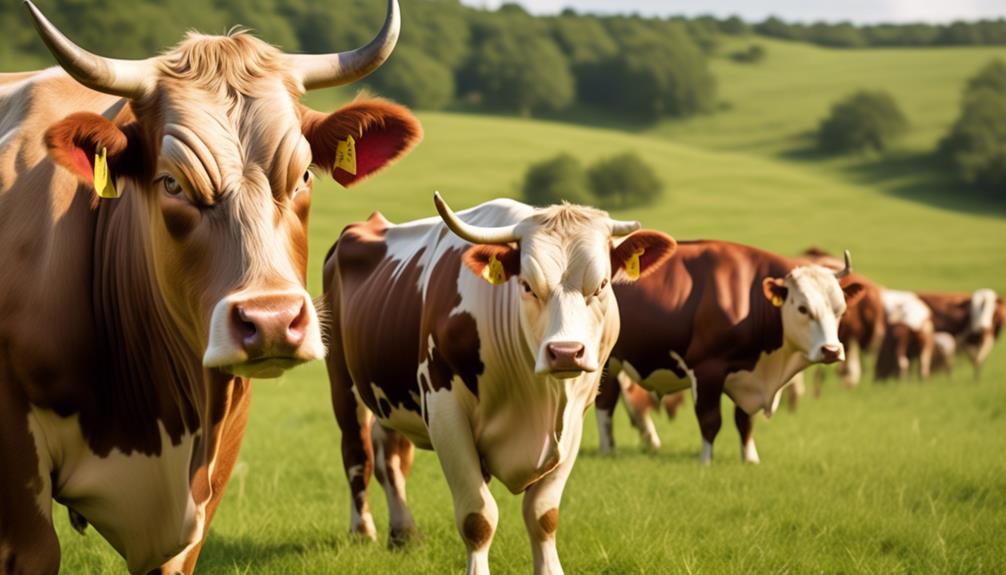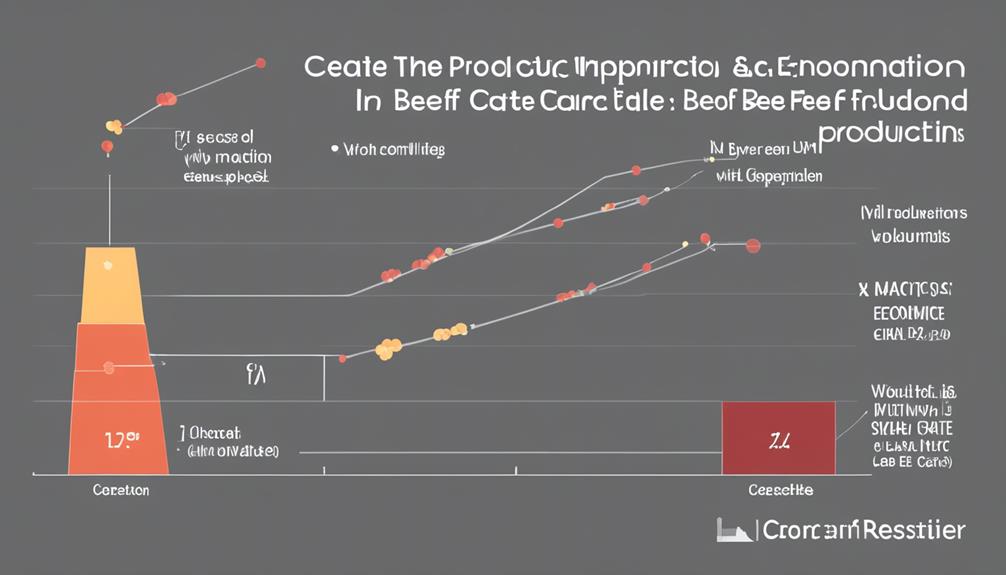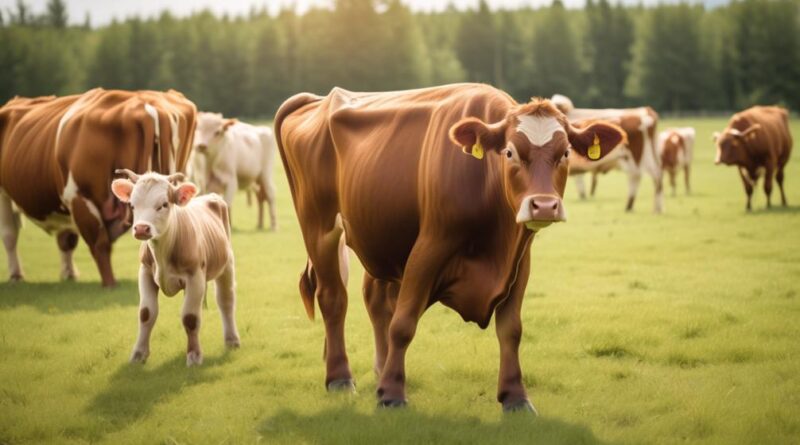Why Is Reproduction Optimization Important for Beef Cattle?
Have you ever considered the impact of reproduction optimization on the overall productivity and profitability of your beef cattle operation? Understanding the significance of this aspect is crucial for the success of your business.
By focusing on reproduction optimization, you can ensure a consistent and high-quality supply of beef, thus enhancing your bottom line. But why exactly is it so important?
Let's explore the key reasons behind this critical aspect of beef cattle management.
Importance of Reproduction Optimization

To achieve maximum productivity, it's crucial to focus on optimizing reproduction in your beef cattle herd. Nutrition management plays a pivotal role in ensuring the reproductive success of your herd. A well-balanced diet, rich in essential nutrients, is vital for the overall health and fertility of your cattle. Providing the right balance of proteins, carbohydrates, vitamins, and minerals can significantly impact the reproductive performance of your herd.
Inadequate nutrition can lead to delayed estrus, poor conception rates, and longer calving intervals, ultimately affecting the overall productivity of your beef cattle operation.
Environmental factors also play a significant role in the reproductive efficiency of your herd. Proper management of environmental conditions, such as maintaining optimal temperature and humidity levels, is essential for ensuring the well-being and reproductive health of your cattle. Heat stress, in particular, can have detrimental effects on reproduction, leading to decreased fertility and lower conception rates.
Providing adequate shade, ventilation, and access to clean water can help mitigate the negative impact of environmental stressors on your herd's reproductive capabilities.
Factors Affecting Reproduction
Nutrition and environmental conditions directly impact the reproductive efficiency of your beef cattle herd. Meeting the nutritional requirements of your cattle is crucial for optimal reproductive performance. A well-balanced diet that includes the right amount of energy, protein, vitamins, and minerals is essential for the overall health and reproductive success of your herd. Inadequate nutrition can lead to delayed onset of puberty, irregular estrous cycles, and decreased conception rates, all of which can significantly impact the productivity of your operation. Therefore, it's vital to work with a nutritionist to develop a feeding program tailored to meet the specific needs of your beef cattle based on factors such as age, weight, and stage of production.
In addition to nutrition, environmental influences play a significant role in the reproductive efficiency of your herd. Factors such as temperature, humidity, and the presence of predators can cause stress, which may negatively affect the reproductive performance of your cattle. High levels of stress can disrupt estrous cycles, decrease libido in bulls, and lead to lower pregnancy rates. Providing a comfortable and low-stress environment for your cattle, including access to shade, clean water, and proper handling facilities, is essential for maintaining optimal reproductive efficiency.
Reproductive Technologies for Cattle

Reproductive efficiency in beef cattle can be further enhanced through the use of advanced reproductive technologies. These technologies play a crucial role in improving genetic selection, increasing the rate of genetic progress, and maximizing the reproductive potential of cattle.
Two key reproductive technologies that have revolutionized the beef cattle industry are artificial insemination (AI) and embryo transfer (ET).
- Artificial Insemination (AI): AI involves the collection of semen from superior bulls and its subsequent insertion into the reproductive tract of a female cattle to achieve fertilization. This technology allows for the utilization of genetically superior sires, leading to improved herd genetics and increased productivity.
- Embryo Transfer (ET): ET involves the removal of embryos from a genetically superior female (donor) and their transfer into recipient females with superior maternal characteristics. This technology enables the rapid propagation of desirable genetics, accelerates genetic improvement, and allows donors to produce multiple offspring in a shorter timeframe.
- Advanced Reproductive Hormonal Therapies: Hormonal therapies are used to synchronize estrus cycles in donor and recipient cattle, allowing for the optimal timing of AI and ET procedures, thereby increasing the success rates of these technologies.
Breeding Management Strategies
Consider implementing a comprehensive breeding management plan to optimize the reproductive potential and genetic progress of your beef cattle herd. By focusing on breeding management strategies, you can enhance genetic diversity and improve reproductive efficiency within your herd.
One key strategy is to implement a controlled breeding season, which ensures that most calves are born within a concentrated period, allowing for uniformity in calf size and development. This can be achieved through synchronized estrus protocols or strategic bull turnout.
Additionally, utilizing artificial insemination (AI) can help introduce desirable genetics and improve the overall genetic potential of your herd, leading to superior offspring.
Furthermore, it's essential to regularly assess the reproductive performance of your cattle, identifying animals with subpar fertility and culling them from the breeding herd. This practice not only improves overall reproductive efficiency but also ensures that only the most fertile animals contribute to the genetic progress of the herd.
Moreover, consider utilizing genomic testing to identify animals with superior genetic potential for reproduction, allowing for more informed breeding decisions.
Another crucial aspect of breeding management is maintaining accurate records of breeding dates, calving ease, and genetic lineage. This information enables you to make data-driven decisions, track the genetic progress of your herd, and make informed selections for breeding.
Reproduction and Genetic Selection

To optimize the reproductive potential and genetic progress of your beef cattle herd, focusing on breeding management strategies is vital. This includes incorporating genetic selection into your breeding program. Genetic selection plays a crucial role in shaping the future of your herd, affecting traits such as fertility rates and genetic diversity.
Here are three key aspects to consider when integrating genetic selection into your beef cattle breeding program:
- Trait Selection: When implementing genetic selection, it's important to identify the specific traits you want to improve in your herd. Whether it's focusing on fertility rates, growth efficiency, or disease resistance, targeted trait selection will guide your breeding decisions and contribute to the overall genetic progress of your herd.
- Genetic Diversity: Genetic selection allows you to maintain and enhance genetic diversity within your beef cattle herd. By strategically selecting breeding animals with diverse genetic backgrounds, you can minimize the risks associated with inbreeding and promote overall herd resilience and adaptability.
- Performance Recording: Utilizing performance recording and genetic testing tools can provide valuable data for making informed breeding decisions. By collecting and analyzing data on traits of interest, you can identify high-performing individuals and make selections that align with your breeding objectives, ultimately improving the genetic potential of your herd.
Incorporating genetic selection into your breeding program empowers you to make informed decisions that can positively impact the reproductive and genetic outcomes of your beef cattle herd.
Reproduction and Herd Health
When managing the health of your beef cattle herd, ensuring optimal reproductive performance is crucial for overall herd productivity and sustainability.
Nutrition plays a key role in the reproductive health of your cattle. Providing a well-balanced diet that meets the specific nutritional needs of breeding animals is essential for successful reproduction. Proper nutrition promotes the overall health and body condition of the cattle, which in turn positively impacts their reproductive capabilities. It's important to ensure that your cattle have access to high-quality forage, clean water, and any necessary supplements to support their reproductive functions.
Disease prevention is also closely linked to reproductive success in beef cattle. Implementing robust herd health management practices, such as vaccination programs and biosecurity measures, can help minimize the risk of diseases that may negatively impact reproductive performance. By preventing and controlling diseases, you can safeguard the overall well-being of your herd and reduce the likelihood of reproductive issues.
Additionally, regular health monitoring and proactive veterinary care are essential components of maintaining optimal reproductive health in your beef cattle herd. Conducting routine reproductive examinations and seeking prompt veterinary attention for any signs of reproductive disorders can help identify and address potential issues early, ultimately supporting the long-term reproductive efficiency of your herd.
Economic Impact of Reproduction

Maximizing reproductive efficiency in your beef cattle herd directly impacts the economic viability of your operation. The economic benefits of achieving high reproductive efficiency are substantial and can significantly impact your bottom line. Here's how it affects your operation:
- Maximizing Profits: Improving reproductive efficiency leads to more calves being born, which translates to increased revenue for your operation. Higher calving rates mean more calves available for sale or replacement within your herd, ultimately contributing to higher profits.
- Breeding Success: Efficient reproduction ensures that your cattle are breeding successfully, resulting in a more productive and sustainable operation. It reduces the need for costly interventions and allows for a more natural and efficient breeding process, saving both time and resources.
- Economic Benefits: Higher reproductive efficiency minimizes the cost of production per calf, as well as the cost of maintaining non-productive animals. This efficiency directly impacts the overall cost-effectiveness of your operation and contributes to long-term sustainability and profitability.
Focusing on reproductive efficiency in your beef cattle herd is crucial for maximizing profits and ensuring the economic sustainability of your operation. By optimizing breeding success and achieving higher reproductive rates, you can significantly impact the financial success of your cattle operation.
Future Trends in Reproduction Optimization
As you look ahead to future trends in reproduction optimization for beef cattle, consider the potential impact of technological advancements on breeding success and economic efficiency. Genetic diversity will likely play a crucial role in the future, as breeders seek to enhance the overall health and resilience of beef cattle. With advancements in genetic technologies, such as gene editing and marker-assisted selection, breeders can now more precisely select for desirable traits, including improved reproductive performance and climate adaptation.
Climate adaptation is becoming increasingly important in beef cattle reproduction optimization. As environmental conditions continue to shift due to climate change, there's a growing need for cattle breeds that can thrive in varying climates. Future trends may see a greater emphasis on breeding for heat tolerance, disease resistance, and feed efficiency to ensure that beef cattle remain productive and healthy in the face of changing environmental challenges.
Moreover, the integration of big data and artificial intelligence into reproductive management practices is expected to revolutionize the industry. These technologies can provide valuable insights into reproductive patterns, enabling more informed decision-making and ultimately improving breeding success rates. By leveraging data analytics, breeders can optimize mating strategies and enhance overall reproductive efficiency, leading to significant economic benefits.
Frequently Asked Questions
What Are Some Common Misconceptions About Reproduction Optimization in Beef Cattle?
Common misconceptions about reproduction optimization in beef cattle include underestimating its economic benefits and the potential impact of reproductive technologies. It's crucial for genetic diversity and requires effective reproductive management to enhance reproductive efficiency.
How Does Climate Change and Environmental Factors Impact Reproduction in Beef Cattle?
Climate change, such as heat stress, can impact reproduction in beef cattle. Nutritional management and genetics selection play crucial roles in optimizing reproduction. You must consider these factors to ensure successful breeding and herd sustainability.
What Are Some Ethical Considerations When Using Reproductive Technologies in Beef Cattle?
When using reproductive technologies in beef cattle, ethical considerations are crucial. Genetic selection must balance progress with animal welfare. It's essential to prioritize the well-being of the animals, ensuring that advancements are made responsibly.
How Does Stress and Social Dynamics Within a Herd Affect Reproductive Success?
Stress factors like overcrowding or dominance hierarchy can disrupt social dynamics within the herd, impacting reproductive success. Behavioral influences and herd management play crucial roles in minimizing stress and promoting optimal reproductive outcomes for beef cattle.
Are There Any Potential Risks or Drawbacks to Focusing Solely on Reproduction Optimization in Beef Cattle?
Focusing solely on reproduction optimization in beef cattle can have potential drawbacks. It may impact environmental sustainability, pose health risks due to genetic diversity reduction, and lead to long-term negative effects on the herd's overall resilience.
Conclusion
So, now you understand why reproduction optimization is crucial for beef cattle.
By managing factors like genetics, health, and breeding techniques, you can improve the overall productivity and profitability of your herd.
With advancements in reproductive technologies and genetic selection, the future looks promising for beef cattle producers.
Keep focusing on optimizing reproduction to ensure the success of your cattle operation.
